|
|
|
|
|
|
|
|||||||||||||||||||||||||||||||||||||||||||||||||||||||||||||||||||||||||||||||||||||||||||||||||||||||||||||||||||||||
|
How Bending of the Oar Destroys Your Rig
Consider the following situation: You’re rigging up a boat to be used exclusively by one crew, it’s a newish boat, all well-engineered and tight. You’re paying attention to getting all the pitches just right, accurate to 0.1 degrees, all the spans, inboard, height etc all good to within, say, 0.25cm. The oars and gates are new, no wear. You’ve customised and controlled everything you can, you have four (or eight, or two) strong athletes to put into the boat, and you’ve adjusted their rigs to give them all the same arcs. Now take a look at this YouTube clip. It's a bit dizzying, but a few seconds should make the point. Alternatively, look at the following pair of stills: 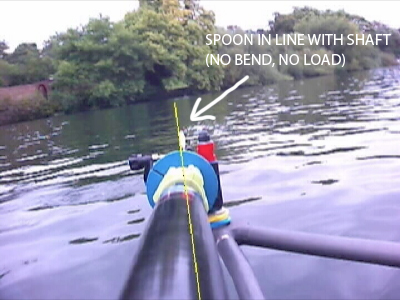 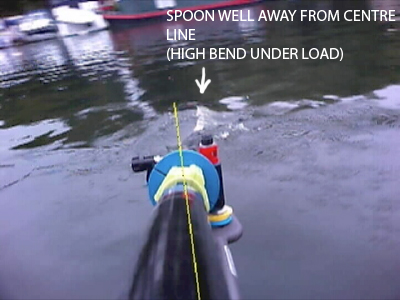
It’s me, sculling at half pressure using newish Dreissigacker standard-stiffness low-i sculls. I attached a camera to the oarshaft just below the handle. The yellow line, added afterwards using video-editing software, stays at the original rest position of the unbent shaft. You can see that the shaft bends a lot during the stroke. This means is that the angle that the blade makes with the water (the "cant angle" to engineers) will change a lot during the stroke, and clearly this is very different from what an unbent oar/scull would make. And, the angle depends on the amount of force applied by the rower. Furthermore, because the amount of force changes during the stroke, so the angle changes continuously during the stroke too. The problem is this: it would be fine if all your rowers were exactly as strong as one another, but generally they aren’t. Which means that in spite of having everything rigged up "to perfection", the angles the rowers’ blades make with the water will all be different from one another, and will change all the way through the stroke. The video should show that these cant-angle differences are easily large enough to screw up the "crew-ness" of the unit. It’s as if they all had very different spans, for example. How to solve the problem? I can think of three ways: 1. Ensure your rowers are exactly the same strength as each other at every point of the stroke; 2. Issue them with variable-stiffness oars, softer ones for the weaker rowers and stiffer ones for the stronger ones to ensure everyone bends the same; 3. Use oars that bend a negligible amount under rowing-type loads, in other words, much stiffer oars. I favour the last one, and it’s perfectly possible to make them. However several famous scullers in the 80s experimented with ultra-stiff sculls and decided they didn’t like them. This seems to fly in the face of "stiffer is better" in almost all aspects of other top-level sport and engineering where power-transfer-across-structures takes place (think sailing, cycling frames and motor racing). Were I a coach, I would certainly try this in a quest to harmonize all the controllable variables in making a crew, though it might take a while to adapt to and benefit from the difference (which is equally true for even the smallest changes to technique or set-up). |
|||||||||||||||||||||||||||||||||||||||||||||||||||||||||||||||||||||||||||||||||||||||||||||||||||||||||||||||||||||||
|
The Recovery - Quantitative - Optimising the Run
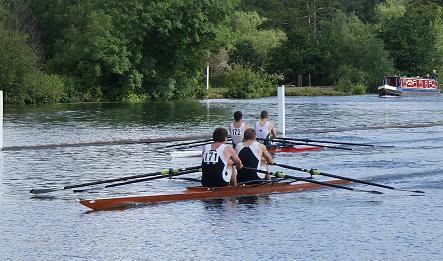 Previously under this heading I wrote:
"Trying to manage the run of the boat during the recovery is a waste of time. ... when the blades are out of the water after the
finish, the boat and crew will move the same distance whatever the crew does between then and the next catch."
It turns out that this is wrong. It is possible and worthwhile to manage the run of the boat. I had enough nagging doubts to do the physics and the simulations for myself, rather than simply to take others' work as given. The following tables show simulation results for two boat types and 5 different recovery profile alternatives. The rower and shell have been modelled as two moving masses separated by a fixed distance 0.45m, drawn together in a fixed time, 0.60s, by an internal force between the two masses. The shell mass also has fluid drag acting on it, which has been modelled as Drag = K.v^2 . The value of K is treated as a constant, but different for each boat type. K has been estimated from my own accelerometer data, as 4.55 for a 1x and 7.0 for a 2x. The process has been modelled over 6000 time intervals of 1/10000 th second. The data I have presented have been computed for a single scull with an initial velocity 5.0 m/s, rower weighing 83kg - 2kg (assumed feet weigh 2kg) = 81kg, and shell weighing 14kg + 2kg = 16kg. And a double scull with same initial velocity, crew weighing 87 + 83 - 4 = 166kg, shell weighing 28kg + 4kg = 32kg, incidentally the same double as the photo above. (profile charts further down):
CoM Travel During Recovery - Single Scull initial velocity 5.0m/s
CoM Travel During Recovery - Double Scull initial velocity 5.0m/s
CHIEF CONCLUSION: START SLIDING SLOW, SPEED UP (i.e. PROFILE C) Profile C allows the CoM of a single scull to travel over 3 cm further than its "opposite" (profile B), and nearly 2 cm further than a typical recovery profile. This best-minus-worst difference scales up over 210 strokes to nearly 7 metres in a 1x and over 5 metres in a 2x!! And, although I haven't presented it here yet, the energy cost between the two is negligible. The main conclusion seems to be that the later you delay the sliding for a given available time and distance the better, subject to how much work you have to do to achieve it. (will add more detailed work/energy discussion at later date). More discussion after the images... Profile Illustrations (generated using data for 2x) 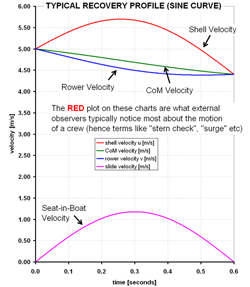
A: Typical Recovery Profile (sine curve) 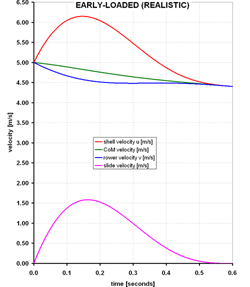 ..
..
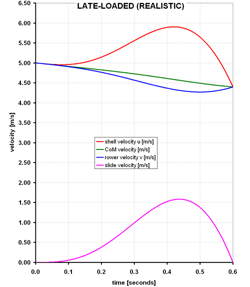
B: Early-Slide and C: Late-Slide Profiles 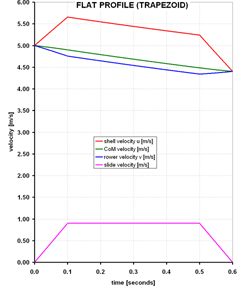 ..
..
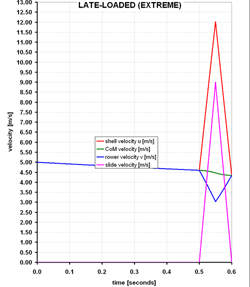
D: Flat (trapezoid) and E: Extreme Late FURTHER OBSERVATIONS & CONCLUSIONS ONLY FOR EXPERTS - ICING ON THE CAKE Although this recovery optimisation appears to be well worth striving to achieve, it should probably only be introduced to crews or scullers who are already very capable and able to change style easily, because one is effectively trying to teach a "rushed" 2nd half of recovery, and great skill will be required to decelerate the shell-draw-back in a sufficiently controlled fashion to take the catch quickly and effectively. Bear in mind it often takes years to teach novices to learn to be in control of the recovery. BOAT-CHECK CAN BE GOOD! Compare the red (shell velocity) plots between the early-loaded and late-loaded profiles (B and C above). The "good" profile shows considerable shell-check just before the catch, whereas the "bad" one shows a much smoother shell progression during this interval. So ironically it seems that pronounced shell-check can in fact be a symptom of very good rowing, as long as it occurs before full compression. I find it interesting that the same observation can be a symptom of either very good technique or poor technique, depending whether this check happens just before or just after full compression. A coach will have to be highly enlightened to tell the difference. FLAT PROFILE It seems intuitive that the flattest profile possible would be the optimum, but actually the flat profile modelled here is hardly different in any respect from the typical one. "EXTREME" LATE SLIDING As an extreme case, I modelled a physically impossible situation where all the sliding occurs in the final 0.1 seconds available. In that time, relative shell-rower velocity must climb to over 20 miles per hour (9 m/s) in 0.05 seconds, and back to zero in the next 0.05 seconds! The model also suggests that the force required from the hamstring muscles to produce this will be up to 3,000N (and similar resistance for decelerating the shell - knee joints watch out!), compared to up to 180N in the others, and 30-40J of work, as opposed to 1-2J. Hence, not feasible. The strategy appears to be superb in terms of CoM travel in the 0.6s, allowing a "run" of nearly 4cm further than the typical profile. However, it comes at a significant energy cost, which can be partially seen by the significantly reduced CoM velocity at the end of the recovery interval, 8 cm/s slower than the typical case, whereas the more realistic alternative profiles ended up with negligibly different velocities from each other. SLIDING FROM A STANDSTILL What happens if you are at backstops and stationary in the water, and you draw the shell towards you? Without any drag, the CoM will not move and will be perfectly stationary at frontstops. However, in the presence of drag, the model suggests that when you come to a stop, in a "frontstops" position (if you can hold it), the 83kg-man-and-14kg-shell will be very nearly stationary, but not quite, and will have moved a little bit. The CoM will be 0.4cm, 0.7cm & 0.3cm closer to the start line for the typical, early-start and late-start profiles respectively, and will be travelling backwards at a speed of 1.3cm/s, 1.6cm/s & 1.6cm/s . Not sure how useful that is, but interesting nonetheless. A more formal presentation of how I have modelled the situation, including the maths, can be found here. All of this too should be taken alongside my thoughts on sliding technique, which is critical to crew boats.) |
|||||||||||||||||||||||||||||||||||||||||||||||||||||||||||||||||||||||||||||||||||||||||||||||||||||||||||||||||||||||
|
The Recovery - Qualitative (how to slide properly)
 The terms "sliding", "frontstops" and "backstops" are all misleading and not helpful for a useful understanding of what the recovery is about. These terms implicitly presume the opposite of the point that this article is trying to make, which is that... Coordinated recovery for a crew is extremely important, far more important I think than many people realise. Recovery technique is all about the coordination of crewmembers drawing the shell, which is a rigid frame that also happens to double up as the flotation device, back towards themselves. Forget all references to "going up the slide" it’s not what happens. It is very important how the crew visualises the slide-recovery, and how the coach makes reference to it, otherwise trying to adapt or change it won’t make any sense. This is not semantics: in a 4-, the crew’s mass is, say, 340kgs (4 x 85kg). The shell’s mass at FISA minimum will be 50kg, only around 1/7th of the crew’s. The following mental exercises should help to illustrate 1. that you pull the shell towards you, and 2. how destructive it is to execute the recovery badly (i.e. in an uncoordinated way). Thought Experiment 1: Sit on an Ice Rink Try a thought experiment: imagine sitting, legs straight out, on a frictionless surface, say an ice rink, with a 10kg weight on top of your shoes. Now lift your knees. You’ll find it will be the shoes that come towards you, not you towards the shoes. This is what is happening in a boat/rower system on the water, elevated to a velocity of 3-6 metres per second. When you lift your knees, you bring the boat towards you, you are not travelling towards the stern. Thought Experiment 2: Ladder Experiment Try a thought experiment, or even better do this for real: get 4 people to hold a horizontal ladder, each person say 3 rungs apart. Now get those 4 people to start walking steadily, still holding the ladder. Now get them, while still walking at the same speed, to draw the ladder towards them the distance of one rung, and away again. It should be easy. Now do the same again, still walking, but this time get just one of them to draw the ladder towards him by 1½ rungs. He will cause considerable upset amongst the rest of the ladder-holders, because he will either have to physically pull all three others towards him an extra ½ rung, or himself towards them, or most likely a bit of both. Either way, he will cause internal actual forces between the ladder-holders, and considerable disruption to what could be a very easy back-and-forth motion. This is exactly what happens in a crew that doesn’t do the recovery together, and furthermore in a crew with big size differences between members, those forces are inevitable and must be tolerated and managed. Thought Experiment 3: Coxless Three Imagine everyone in a crew starts the recovery exactly together, except one: this one person is late starting the recovery, so until he starts he is effectively part of the shell, and the rest of the crew are trying to draw not just the shell towards them, but his mass as well! In a coxless four, the recovery will initially feel like a heavy coxed three with a massive cox! Try the two scenarios in a stationary boat and see how different they feel. Also pick a reference point in the water, a twig or leaf, and see how it is really the boat that mostly moves towards you, and you remain more or less where the leaf is. 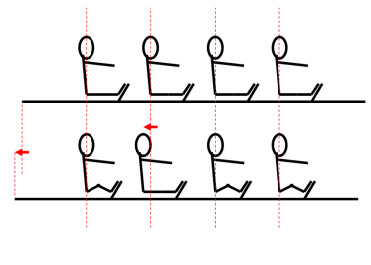
* * * Even if you manage to get into and out of the water together, the internal forces created by having to drag people towards you and away from you every stroke will cause useless internal energy expenditure and therefore reduce the amount of work available to actually propel you to the finish line. Furthermore the likelihood is that the disruption will seriously affect the synchronous blade entry/exit/drive, making for an ineffective crew. Also these forces will have no effect on the run of the boat (they’re internal forces to the boat/rower system). The Ladder argument, no. 2 above, should demonstrate that anyone with shorter legs in a crew will be unable to draw the shell back as far as the longer legged people, so either i. all crew members row short to the shortest member, or ii. the longer-legged members end up drawing back the shell plus the shorter crewmembers for part of the sliding distance, which will make the recovery feel "heavy". In practice a real-world crew made up of actual real different-sized people probably ends up as a mixture of both i and ii. The former (all rowing to the shortest member) will likely feel more "comfortable" but may not be most effective in terms of using all available work. A coach's job, starting with a crew who all start the recovery draw-back at more or less slightly different times and which contains differently-sized people, is to approach that sweet spot where everyone starts the recovery simultaneously, where the inevitable differences in shell-draw-back distances are smoothed out so that the feeling of "fighting" the other members (remember the ladder) is minimised, and everyone feels they can reach the catch relaxed and get all their work down. |
|||||||||||||||||||||||||||||||||||||||||||||||||||||||||||||||||||||||||||||||||||||||||||||||||||||||||||||||||||||||
|
The Catch - Is a Quick One Important?
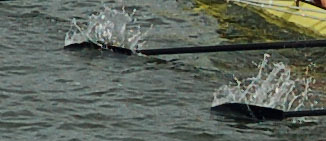 We have all seen or heard coaches emphasising the importance of a “quick catch” and taken it as read that quick=good and slow =bad. But take a step back and ask a few questions: 1. Why is a quick catch important, in fact is it important? 2. What are the consequences of a slow catch? 3. How quick is “quick”? 4. What’s actually going on at the catch anyway? To address these questions, I'll start at number 4, and answer the rest in reverse order. What’s actually going on at the catch? You may think that during the drive, blade face meets water; water drag resists the blade; you the rower feel that resistance via the pull on the handle. You would be partly wrong, and especially so at the catch. Certainly throughout the whole drive there must be a perpendicular force at the blade but the nature and source of that force is not what most people think. Look at video, especially from above, and you will see that the blade enters the water like a spear, tip first and with minimal splash. The blade face is NOT introducing itself to the water “side-on”, so there cannot at the outset be a sideways drag force. And yet from the very moment it enters the water there definitely IS a sideways force acting on the blade. How can this be? Consider what is happening: the blade enters the water at speed, tip-first without splash, it’s travelling along its axis into a fluid. The blade itself is curved: the back face is convex, the front face concave. A fluid (water) is travelling at speed up both sides of this blade face towards the handle. When a curved surface travels edge-on through a fluid, you are dealing with a wing. “Lift” is produced, and lift acts in a direction more or less perpendicular to the wing surface. Thus the sideways force felt on the blade at and from the catch is lift. 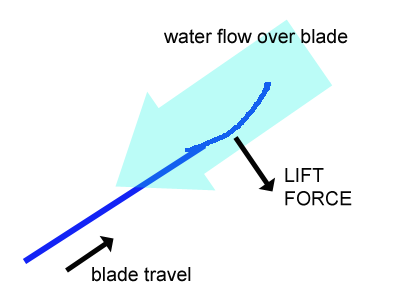
what's going on at the catch Now turn attention to the middle of the drive. The resistance you now feel at the handle is indeed produced by trying to drag the blade face-first though the fluid, and there is a great deal of slip of the blade past the water (about which more later). Thus as the drive progresses from catch to mid-drive to finish, the sideways force at the blade face starts off as almost entirely lift, at mid-stroke it’s entirely blade-face drag, and by the finish it’s back to a high proportion of lift (as the water is now flowing along the blade face again when the blade gets pulled away from the water). During the first third of the drive the resisting force is transitioning from lift to drag, and back again from drag to lift towards the finish. 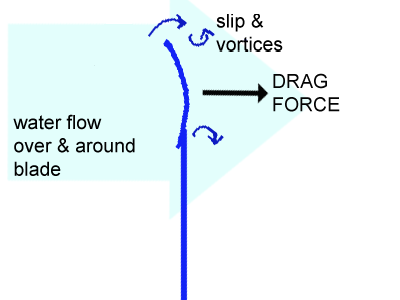
what's going on mid-drive Lift is a very efficient force from the point of view of rowing, in that almost all the force produced by it contributes to the motion of the boat-plus-rower, and very little of it does any work to the water. Fluid drag, on the other hand, is a very inefficient force by the same criteria. As much as 40% of the work done via the blade face trying to force itself face-first through the water is spent on blade slip, vortex-and-wave creation, sound and splash. This slip, vortex and splash energy loss is a complete waste, i.e. it makes no contribution to the speed of the boat-rower. But it is still work that is produced by the rower, and is thus subtracted from the remaining available work which actually helps move the boat. 40% is a huge proportion, particularly given that races are won and lost by tiny margins. It follows that rowers would do well to try to arrange things so that as much of the available effort as possible is done against lift rather than drag. The obvious way do this is to be rigged as far forward as possible. It may be necessary to make alterations to other parts of the rig or technique to allow this. Another way might be to use oars or sculls with a different “cant angle” (imagine bending the blade back on the shaft). Certainly more research needs to be done to optimise blade design. The two other popular water-and-vessel based sports, sailing and canoeing, have long ago realised the benefits of optimising for lift. Canoe paddles used to be employed much like rowing blades: stick a big flat plate into the water, drag it past you, move forward. Nowadays these paddles are highly sculpted, smoothed and have a wing-shaped cross-section. You stroke it sideways in the water and it’s the resulting lift which provides the resistance against which you propel yourself. Almost all the work done helps move the boat. Certain types of sailing boats use their sails as huge wings rather than “direct push surfaces”, pointing into the wind rather than across it or directly in front of it. They call this "apparent wind" sailing, and it means that these types of boat travel downwind in a zig-zag fashion much more quickly than if they were simply sailing "before" the wind. Rowing has yet to “see the light”. Anyway, back to the point. It should be clear that there’s a lot going on at the catch, and we’re now in a better position to answer the other questions. How quick is “quick”? First I need to define the catch time, and before that it’s useful to explain what’s going on around the catch. During the recovery, off the finish, the shell is accelerated/pulled by the feet underneath the crew. At the end of the recovery, “into frontstops”, the shell is decelerated/pushed by the feet until momentarily the rower and shell are stationary relative to one another. At this point the catch starts to happen, and some time later the shell “notices” the thrust exerted by the oars and starts to speed up again. I have defined catch time as this time from the moment of frontstops until the point that the shell deceleration has been overcome by the start of the drive. See the following plots, comparing the typical catch profiles of two scullers that I have measured using my accelerometer setup (see elsewhere on this site for details). One a very skilled sculler, who seems to manage to go faster than anybody no matter how unfit: he's a natural, and especially good in very bad water. The other sculler is a typical club sculler, very experienced, reasonably quick, but nothing special.
Accelerometer Plot of Very Good Sculler: 0.10 seconds
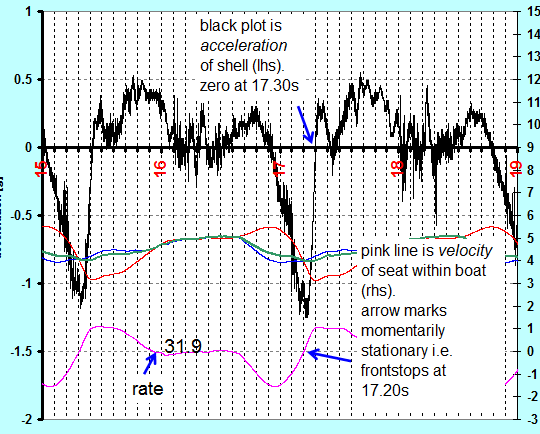
Accelerometer Plot of Experienced Club-Level Sculler: 0.17 seconds 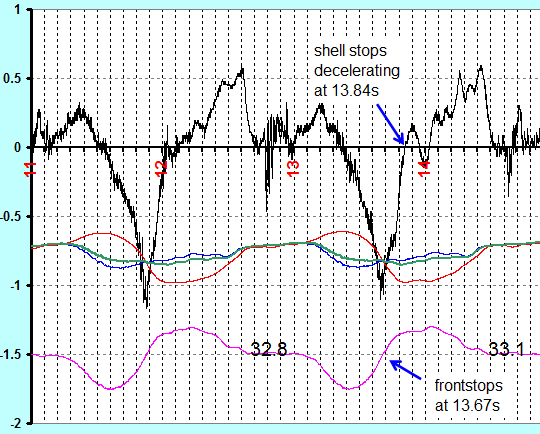
Look at video of a reasonable crew or sculler and you’ll see that typical time from maximum reach to fully buried takes 4-5 frames, which at 24fps equates to around 0.2 seconds. My own data and plots from accelerometers shows that for a very good sculler, this can be as little as 0.08 seconds, and for a poor one as much as 0.5 seconds. “Quick”, as far as my observations suggest, is therefore 0.1 seconds or less. “Slow” would be 0.25 seconds or more. What are the consequences of a slow catch? During the catch phase, before there's any resistance to handle-pull, you are losing compression and missing water. The data table below, for a single sculler, shows this "lost compression" or "missed water" handle-travel distances for different catch angles and catch times, using a few reasonable assumptions about rig and speed. The boxes highlighted in yellow are suggested as "typical" range of values. (For my method for deriving these values download a pdf here.)
Total Handle Travel [cms] During Catch for Various Catch Angles and Catch Times
aka Missed Drive
I have used handle-travel instead of slide travel because I think it is easier to visualise and we as rowers have a better feel for it ... after all handle-travel happens right in front of our eyes! Thus the consequence of a slow catch is a loss of the most important and efficient part of the drive: i.e. opportunity to get work done against lift; also, a loss of compressed position. Once the compression has gone, the opportunity to get the work done from the big muscles is gone. (I should mention that an assumption I have made to simplify the maths is modelling the shell travel as a constant speed during the catch phase. Clearly this is not strictly true, but in assuming a minimum velocity through the catch phase, the results and conclusions hold. Any periods of higher shell speed than this will simply make the values in the table above larger.) Why is a quick catch important, in fact is it important? By now it should be clear that a quick catch is very important, and it's no coincidence that the quickest catches seem to observed in the quickest crews. The quick catch is critical because a slow catch quickly wastes the compressed position, and loses the opportunity to get work done against lift, which only exists in the very first part of the arc. Conclusion After learning to balance and do everything together, the most important learning curve for a crew or sculler is to acquire the skill of the "quick catch". Unfortunately, it's a skill that only comes from confidence, poise and a lot practise. In the case of my own sculling and rowing it's a reflex action: I'm not actually conscious of doing anything to pick the water up, it just happens. If you do consciously try to "quicken the catch" for a given stroke, you'll probably actually slow it down. |
|||||||||||||||||||||||||||||||||||||||||||||||||||||||||||||||||||||||||||||||||||||||||||||||||||||||||||||||||||||||
|
Feet Out
"Feet Out" at the start of an outing, going from backstops-paddling to full slide with feet simply on top of the shoes (but heels in the heel-cups) is in my opinion the single most effective exercise to bring a crew together and extract as much crew-propulsive efficiency as possible. Ideally, and conditions permitting, each stage (e.g. arms-only, body swing ... etc) should be done for an extended distance, not the 10 strokes at a time normally done, at very light pressure and with squared blades. Do not get me wrong, this has nothing to do with "letting the shell come towards you by itself" - the laws of physics do not allow that. The crew must necessarily physically pull the shell towards them each stroke with their hamstrings (see sliding technique), and to do that the feet MUST be somehow hooked to the stretcher. Even with "feet out", the heels are still deep enough into the heels to allow the rower to pull the shell back against the friction of the moving water. No, the point of feet out is it makes the crew exquisitely sensitive to all the things it needs to do to "get together", namely synchronising the timing of catch and finish, matching the hands-away heights to keep the boat balanced, balancing the pressures with your partners on the other side of the boat (see symmetry), not dipping excessively after the finish (one of my own bad habits), recovering/sliding together, keeping relaxed. If this looks like a repetition of the same topic in Summer Training Program, I make no apology, it reflects the importance I attach to it. |
|||||||||||||||||||||||||||||||||||||||||||||||||||||||||||||||||||||||||||||||||||||||||||||||||||||||||||||||||||||||
|
Checking the Boat
"Checking the boat" is a term describing when the rower starts the leg-drive before the blades are properly buried. From the viewpoint of a coach in the launch, the shell will appear to slow more suddenly at the catch than it would if the blades were being instantaneously buried. It is normally leapt on by coaches and observers as a mortal sin. Many people think that checking the boat slows you down. In fact it does the opposite: it speeds you, the rower, up. Technically, checking the boat does indeed slow the shell in the direction of the finish line, but it also speeds up the bodymass by an exactly equivalent amount, so no energy is lost. The law of conservation of momentum ensures this. It is in itselfnot the mortal sin that most people think it is, although it is often just one of a panoply of errors symptomatic of a slow crew. That’s not to say that checking the boat is desirable, generally it isn't (but see the notable exception at the end of this article). Driving the legs before the blades are properly buried simply costs you the first part of the compressed position, that’s all. If by the time you do get connected you are still able to expend all the work you have available for each stroke before the finish, and everybody is "missing water" in the same way, then not much is lost. In a single, where crew-togetherness is not an issue, it's even less of a problem. In a crew if just one member is driving before buried, then it's less an error of checking than of crew togetherness, and is likely to be accompanied by other more serious errors. However, in certain probably rare cases, apparent checking can actually be a sign of an extremely good crew ... see "The Recovery - Quantitative" above. |
|||||||||||||||||||||||||||||||||||||||||||||||||||||||||||||||||||||||||||||||||||||||||||||||||||||||||||||||||||||||
|
Looming
I never used to have strong views on looming, but a recent (at time of writing) discussion on rec.sport.rowing has changed this. It seems that the subject of looming, or more properly "correct" blade depth is potentially an important thing to get right, and can be expensive to get wrong in terms of significant wasted energy. Surprising though it may sound, far from being a sin, looming is actually essential, aiming to keep the shaft 30cm inboard from the blade wet. Go to the thread itself or read what Carl Douglas posted when starting the discussion:
"P35 [of an edition of Rowing News] has 2 sentences on blade depth:
'Sit at the catch with the blades buried - just the blade and not the
shaft. See where your handle height is and then try to maintain it
through the drive'.
Whence this belief that none of the shaft should be in the water? Whence its corollary - that the top of the blade should run at surface level & no deeper? Where are the written analytical or experimental justifications for these popular mantras? A blade should not wash out, as it then moves through the water rather than staying with it, stirs it to froth, doesn't move the boat so well & thus - in the words of Sellar & Yeatman - is a Bad Thing. Indeed, the final paragraph on that same page correctly identifies the need for tight, dark puddles. Which is blindingly obvious, but in conflict with what went before. The physical processes around an immersed oar with a variable depth of immersion have no reason to flip abruptly as the top of the blade submerges. So how & by whom was it decided that, suddenly, it all changes immediately the blade reaches its flotation depth? What physical transformation introduces a discontinuity or reversal at that point by introducing a new & contradictory set of rules? Yes, the oar shaft, being circular in section, is not best shaped for boat propulsion - it slips too easily through the water (hence that flatter bit at the end - the blade). But that means its drag will also be rather low. Are we so dumb that we must invent fictitious rules defining precise go/no-go boundaries? Some simple facts: 1. The performance of the blade certainly improves progressively as it goes from non-immersion through partial immersion (washing out) to so-called full immersion (top edge level with water surface). But it continues to improve as you go yet deeper. There is no sudden cut-off. 2. Immersing part of the shaft in the water is, at the worst, a very slight source of drag but, when the boat is being rowed hard, at mid-stroke the blade "turns" in the water not about its centre but around a point a short way up the shaft from the blade. And the concept of a point of rotation is anyway meaningless near catch & finish. 3. So a fair (if variable) chunk of the shaft can be immersed before it can cause _any_ parasitic drag in the water. Until then it actually contributes, marginally, to overall propulsive efficiency around mid-stroke, where most energy is otherwise lost. 4. If you do go a tad deeper, to where water is slightly back-watering over the shaft, that water is still moving but slowly relative to the immersed shaft so, drag losses being proportional to the cube of relative velocity between water & shaft, any net losses will remain trivial for some continued increase in depth. 5. Meanwhile, the deeper you row the blade, the less chance of air being entrained behind it. That entrained air, by forming a cavity behind the loaded blade, drastically cuts the essential _tensile_ connection between blade & solid water (it's the back, not the face, of the blade which transmits the propulsive forces into the water). Thus, up to a surprisingly great depth, the deeper the blade goes the greater its efficiency becomes. [emphasis added] Since going deeper that the popular prescription continues to increase blade efficiency, & since it only slowly, if at all, incurs any penalty from shaft back-watering, a fairly strong case can be made for rowing deeper than conventional wisdom suggests. And, FWIW, study of blade depths of the more successful rowers & crews tends to support that case. Despite the above, which is simple to follow, our sport widely maintains a collective faith in the spurious concept of a divinely-ordained blade depth limit. Apologies if, inadvertently in the above, I just broke any treasured icons." When I was a novice, I was told that net pitch at the blade should be 6 degrees, but should be reduced as you get better. I'm not sure that whoever gave me this advice was thinking about this issue when he said it, but it's good advice nonetheless. Consequently, I have become used to sculling with 3 degrees of net pitch and very well buried blades! |
|||||||||||||||||||||||||||||||||||||||||||||||||||||||||||||||||||||||||||||||||||||||||||||||||||||||||||||||||||||||
|
More Important: Training or Technique?
You may have noticed that most crews go faster at full pressure than at half pressure. This means that, all other things being equal, the more work you do the faster you go, which means that training is indeed an extremely important factor in what makes the crew go fast. However, the "all other things being equal" qualification is critical. It is equally valid to say that, all other things being equal, the better you row the faster you go. The question is, which is more important? In my experience most coaches place far more weight on the training than the technique, for many reasons. It’s much easier to detect a 2 second improvement on the erg than on the water, and the quality of data from ergs and weights is much cleaner than trying to compare times taking wind, stream, different lakes and rivers etc into account, so boatspeed-based selection is necessarily more difficult and often shied away from. How many times have you seen crews selected on erg-scores and going backwards on the water? The answer to the title question is: "it depends". Consider two crews who aren’t going as fast as they should be. For the one crew that’s technically perfect, optimising the training offers the most scope for increasing speed. Unfortunately there aren’t many crews like that. For the other crew that’s already extremely fit and powerful, improving the technique will yield the biggest increase in speed. Also unfortunately, there are LOTS of crews in the latter category. It’s a lot more difficult to speed up a crew by improving their technique than it is to make them do more training, and a coach who can make a crew go faster by his/her own influence than they would have gone on their own is quite a rare animal. |
|||||||||||||||||||||||||||||||||||||||||||||||||||||||||||||||||||||||||||||||||||||||||||||||||||||||||||||||||||||||
|
Summer Training Program
In the late 80s I was lucky enough to be at Tideway Scullers in London and joined the sculling group which produced the crew which had just won the Queen Mother (open M4x) event at Henley Royal Regatta. In 1987 a summer student visited the UK and joined the same group: Canadian Olympic bronze medallist (M4x 1984) and world champion (M4x 1985) Doug Hamilton. He brought with him a summer training program which the club adopted and which I personally have used ever since. A little later in 1989, having just joined Molesey Boat Club, I teamed up with one Andy Graham who brought with him from the Nottingham lightweights-based national squad a "start of outing" routine that I have also used ever since. These two things are the first things I try to teach when asked for advice on training. Summer Training Program
Start-of-Outing Routine On days when the water or wind are not bad, every outing is started with the following routine: Whole Crew from outset. Feet Out of the shoes. Very Light pressure. 500m each step (yes!). Very low rate steps 1 & 2. Aim to be totally relaxed. 1. Backstops Paddling, square blades, arms-only 2. add Body Swing 3. Quarter Slide 4. Half Slide 5. Threequarter Slide 6. Full Slide Depending on conditions, start feathering around step 5. The point of all this, especially the very slow-speed movements at backstops and feet out is that it makes the crew extremely sensitive to tiny variations in crew togetherness, both in terms of balance and equal stroke pressure/pattern in the water. When you get it right the whole crew will be perfectly balanced, each member completely relaxed and the boat will feel rock solid. All this will be passed on to the higher energy rowing. An analogy is karate: I have often seen people practising karate moves in the middle of a field performing extremely slow movements, ironing the movements into muscle memory so that they come out correctly when needed at higher energies. |
|||||||||||||||||||||||||||||||||||||||||||||||||||||||||||||||||||||||||||||||||||||||||||||||||||||||||||||||||||||||
|
SlidingSeat.net / Magnus Burbanks / member of Molesey Boat Club, UK
|
|
|
|
The flexibility of our oars and sculls seriously compromises our careful efforts to align
arcs and rigs. It is possible to manage or optimise the run of the boat, but it's probably only for expert crews
and can look very like boat-check. "Sliding Together" is an extremely important part of what makes a crew, and if done badly,
virtually guarantees a crew won't go fast no matter how much power there is. An analysis of the catch and what's actually going on. It's complicated and there are two serious penalties
for getting it wrong: loss of lift, and loss of compressed position. ... is the very best exercise to improve a crew, but it needs to be done for extended periods
of time and at the start of every possible outing. ...is not nearly as cardinal a sin as is commonly assumed. In fact, in a 1x it's
harmless. But it is often a symptom of a crew with poor technique. ... or rowing/sculling with the blades buried deep, far from being a sin is actually the exact
opposite: it's necessary. They're both "necessary but not sufficient". Judging by the the number of slow "ergo boats",
improvement via better technique is seemingly more difficult to impart to a crew than getting more training in. A highly effective and progressive regatta preparation program, plus an equally effective start-of-outing
routine (training + technique!). |